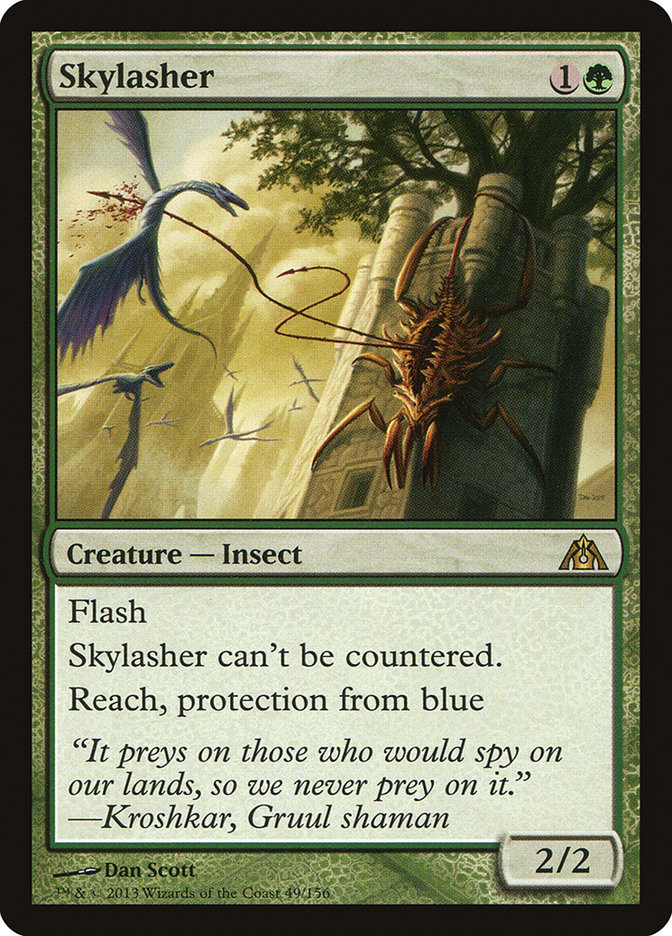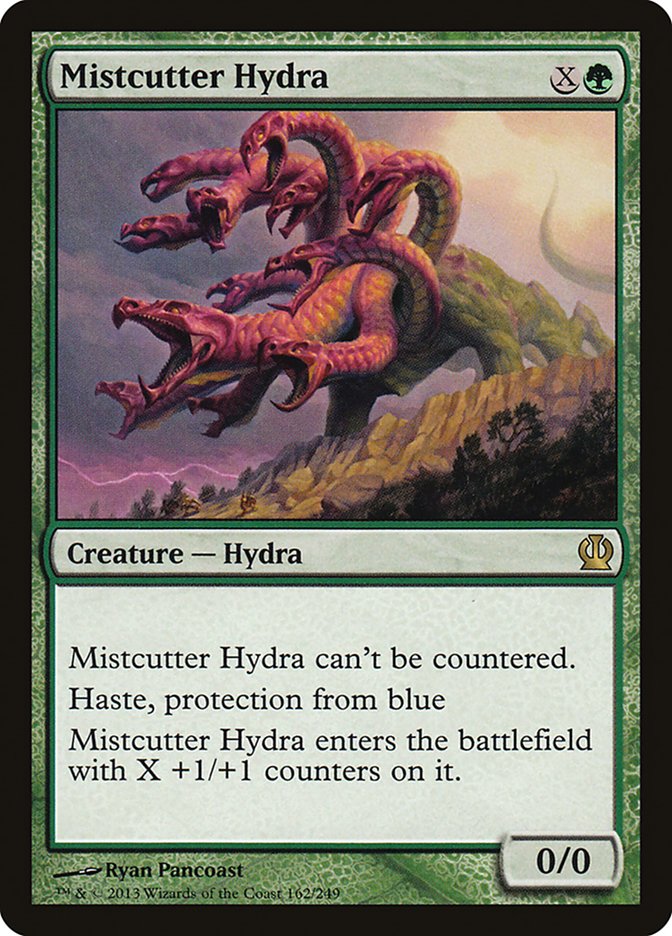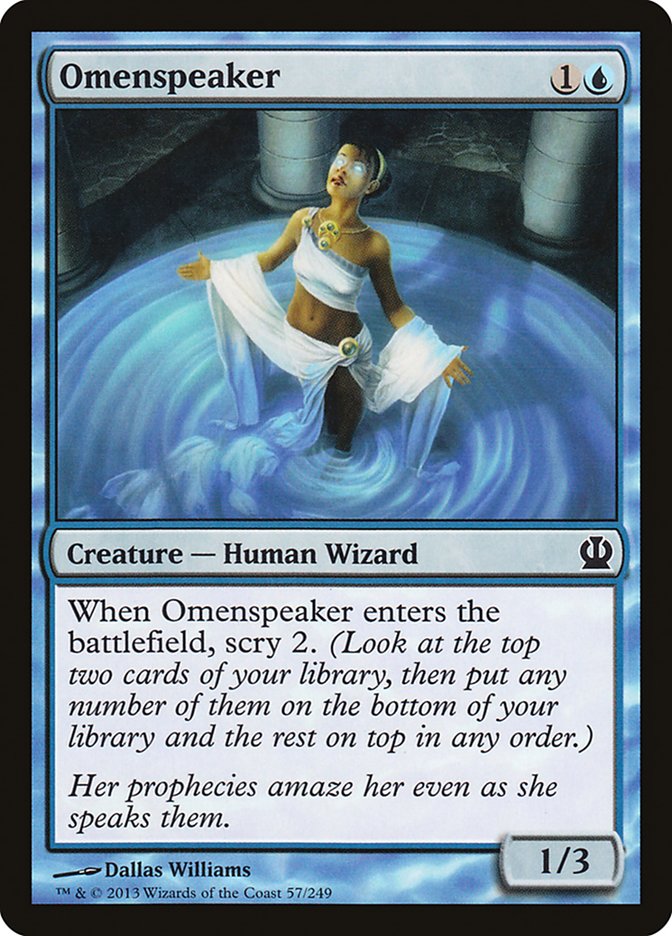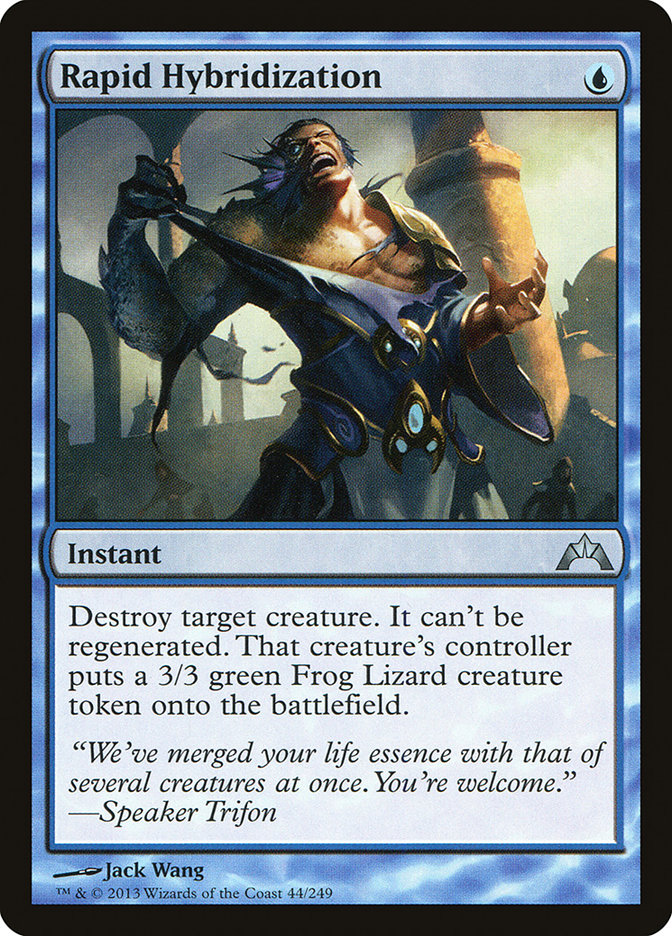After the Pro Tour I expected everyone to be gunning to beat Mono-Blue Devotion, and I thought that Patrick Chapin B/W Midrange deck was going to be well positioned against the field from the Top 8 with the addition of Banisher Priest, so I decided I’d play that at Louisville and stopped thinking about it while I extended my stay in Dublin to vacation with my girlfriend.
I flew from Dublin to Louisville on Friday, and when I got to the site Friday night I ran into William Jensen and Owen Turtenwald, who told me they’d seen a Mono-Blue Devotion deck on Magic Online that cut all the Mutavaults and played four Nykthos, Shrine to Nyxes, four Cyclonic Rifts, and three Opportunitys. They liked the idea of beating the mirror with Nykthos and Cyclonic Rift but thought Aetherling was a better way to spend six mana than Opportunity (I’m not sure I agree).
I told them that I wasn’t playing the deck because I was afraid of Skylashers and Mistcutter Hydras being everywhere, and they asked why I was worried about that. Where was this fear coming from? No one online was playing Skylasher.
After Pro Tour Dark Ascension, the one that Jon Finkel and Jelger Wiegersma made Top 8 of with Spirit Delver, suddenly everyone had Corrosive Gale, and the deck was basically unplayable. I assumed it would be similar this time around. The key difference is that any deck can play Corrosive Gale, while there aren’t that many decks that Skylasher actually makes any sense in.
Moreover, when I talked to people at the site, it became clear that Magic Online was full of Devotion decks but not blue ones in particular—in fact, Mono-Black Devotion was particularly popular (I would guess this is based on the relative prices of the decks), so people likely couldn’t afford to warp their decks too much against Mono-Blue Devotion.
I still had my Mono-Blue Devotion deck put together from the Pro Tour and felt very comfortable with it, while I didn’t have the cards or experience with the B/W deck, so I liked the idea of just playing Mono-Blue again. The question was how much I bought this new Nykthos version.
The answer was that I thought it was too extreme at first, and the more I thought about it, the worse it seemed. You need to be getting a huge payoff to play four copies of a legendary land like Green Devotion does. Cyclonic Rift is good but not that good. Also, if the plan is to cast Aetherling against control decks, you’re actually making it harder to do that by changing the mana in this way—they’re going to have removal to keep your devotion low, and redundant legendary lands will make it harder for you to just put six or seven lands in play.
Moreover, while Huey and Owen said they weren’t that impressed by Mutavault, that just seemed insane to me. The card is easily among the best in the format and is crucial for fighting creatures with protection from blue, attacking control decks, keeping threat density high against removal-based decks like Mono-Black Devotion. I thought about shaving a Mutavault for a second Nykthos since everyone on our team at the PT felt the card performed well and overloading Cyclonic Rift is important, but in the end I just couldn’t see playing less than four Mutavaults.
I liked the Nykthos/Rift plan for the mirror, so I decided to add an extra of each to the sideboard.
I also decided I’d play a bunch of Ratchet Bombs in the sideboard to answer pro-blue creatures. But then I talked to Gaudenis Vidugiris about the list, and he said he didn’t think Ratchet Bomb made sense against the green decks, where it’s slow and bad at dealing with most of what they’re actually doing. That sounded true, and I decided Ratchet Bomb just didn’t fit the deck well and cut them.
I like Omenspeaker as a card but had been frustrated by its weak devotion contribution at the PT. Too often you want to play a two-drop; then Thassa, God of the Sea; then Jace, Architect of Thought or Bident of Thassa; and attack with Thassa, and Omenspeaker doesn’t let you do that, which makes it substantially weaker than the others. Also, we originally had one in the sideboard for white and red aggro decks, but neither of those really existed at this point, so I felt the card was probably unnecessary and poorly positioned.
At the same time, Rapid Hybridization had really impressed me. I sided in at least one in every single round of the Pro Tour, and while I think it’s a little worse in game 1, I felt that was a pretty strong argument for playing one main over the Omenspeaker, so I did that.
The only other change I made to the maindeck was swapping a Bident of Thassa for a Jace, Architect of Thought. I think Jace is much better in the mirror, which now seemed important, and splitting my legendary cards more evenly among different names is definitely good.
Gainsay was great for me at the PT. I was really happy to have three of them, and it only seemed more important now, so cutting the second Negate for the fourth Gainsay was an easy change to make. I never used Aetherling at the PT, so I decided to cut one for a Domestication. I think Domestication is good in the mirror, but I also think you can’t play too many because you really don’t want to fill your deck with four-mana spells. I think people are underrating the importance of being cheaper and faster in the mirror and erring too much toward haymakers over Gainsay.
So I registered the following decklist:
Creatures (28)
- 4 Judge's Familiar
- 4 Frostburn Weird
- 4 Cloudfin Raptor
- 4 Nightveil Specter
- 4 Tidebinder Mage
- 4 Thassa, God of the Sea
- 4 Master of Waves
Planeswalkers (2)
Lands (25)
Spells (5)

I don’t think a round-by-round tournament report is particularly useful here. A lot of my matches were written about or shown in the official coverage. What you want to know is that I played against the mirror about three times, G/R Devotion about three times, Mono-Black Devotion about three times, Mono-White Aggro once, B/W Midrange once (I think), and a Junk deck that didn’t really do anything once, and I didn’t play against Esper Control until the Top 8. My only loss in the Swiss was against Brad Nelson playing Mono-Black Aggro, but I beat the deck twice. A lot of my matches were very close, just like at the PT. I usually went to three games, and I definitely played some that required extremely tight play and a bit of luck to win.
I generally dislike writing sideboard guides. I never have my plans written out. I always just shuffle my sideboard into my deck and pull cards that look bad until I’ve removed fifteen, but with this deck I’ve come to some really solid plans that I’ve been doing consistently and have been really happy with, so I think they’re actually worth sharing.
Against any nonblue deck with four Hero’s Downfalls (Junk, Mono-Black, Orzhov, R/B, etc.):
-2 Cyclonic Rift
-2 Jace, Architect of Thought
-1 Nykthos, Shrine to Nyx
+1 Dissolve
+1 Bident of Thassa
+1 Domestication
+2 Rapid Hybridization
The idea here is that you want to maximize your threat density; you need to keep playing creatures. Their removal generally costs more than your threats, and they generally have to kill all of them because of Thassa, God of the Sea and Bident of Thassa. Because your creatures cost less than their removal, you can usually get hits in with your early creatures while they kill off the new ones you play if you curve out well, and they don’t have as much removal as you have creatures, especially once you factor in Mutavault.
You win if you can stay ahead on the board and get them too low while they struggle to kill enough guys or if they have to use all their removal on weak guys and you stick a Nightveil Specter or Master of Waves. They win if they can slow you down enough to take over the game with a Desecration Demon or clock you with an evasive creature and Gray Merchant of Asphodel.
Negate is tempting because they have so many spells, but you have to be proactive. They have card draw and more power in their deck, so you lose if you both sit there with cards in hand. You need to be on board and need to be proactive, period. Rapid Hybridization is largely there as another creature, but it’s also good to be able to kill Desecration Demon, which is definitely their best card.
One of the things they often do wrong that you can punish them for is have too much discard. Your deck is extremely redundant, and you’re just playing a tempo game, so you’re generally happy when they take time attacking your hand instead of the board.
Against the mirror:
-2 Bident of Thassa
-1 Mutavault
-4 Judge’s Familiar
-4 Frostburn Weird
+1 Cyclonic Rift
+2 Rapid Hybridization
+4 Gainsay
+1 Nykthos, Shrine to Nyx
+1 Domestication
+2 Jace, Architect of Thought
Judge’s Familiar gets trumped by every other flier, doesn’t contribute enough devotion, and its ability doesn’t matter much. Bident of Thassa is the worse four since you have to be ahead to take advantage of it. Frostburn Weird is low impact in a matchup about trumps. It’s there to turn on devotion, but there’s not much removal, so it shouldn’t be hard to have enough devotion. It’s worse than Tidebinder Mage because Tidebinder Mage taps it, so you don’t want to be on the wrong end of that exchange, and Tidebinder Mage also taps Frog Lizards from Rapid Hybridization. Also, Master of Waves has protection from Frostburn Weird.
Mutavault isn’t especially important here because it’s hard to get through with a 2/2 on the ground. You’re cutting it because you want a second Nykthos, Shrine to Nyx since overloading Cyclonic Rift will win most games and they aren’t fighting your devotion, so it will be good, but you don’t want 26 lands and don’t want less than twenty Islands, so you have to cut a Mutavault.
You want cheap interaction because the games are often really based on tempo, and you have to have every answer you can to Master of Waves because an unanswered Master of Waves will almost always win the game.
Jace, Architect of Thought is much better than I originally expected. I thought it would be bad because it will die unless you are ahead in the air and they can kill it with Thassa, God of the Sea. In reality, it makes most creatures attack for very little, so even if they can attack it takes a huge amount of effort to kill, and they often can’t attack with minus one power because your creatures will be bigger than theirs. Also, life totals are extremely important, and it’s often the best way to block against a Thassa when you both have one. Other games will be more about answers and getting ahead with Gainsay, and it also wins on an empty board. It’s one of the best things you can be doing.
Domestication is good. It steals Nightveil Specter, which is another of the best cards, answers Master of Waves productively, and is the only way to kill an opposing Thassa (the only way that I have—there are others, particularly Curse of the Swine). However, cheap answers like Rapid Hybridization and Cyclonic Rift can work well against it, and unlike Jace it isn’t always good (see: empty boards), so I think it’s actually worse than Jace, Architect of Thought and Master of Waves even if it has higher upside.
Against G/R Monsters:
-4 Judge’s Familiar
-2 Jace, Architect of Thought
+1 Nykthos, Shrine to Nyx
+1 Cyclonic Rift
+2 Rapid Hybridization
+1 Bident of Thassa
+1 Dissolve
Judge’s Familiar just doesn’t really do anything, and Jace is slow and easy for them to kill. You need to pressure them and play a tempo game, and you need to beat Polukranos, so you need cheap instants to get rid of it in response to monstrosity. Bident of Thassa is a more reliable source of cards than Jace, Architect of Thought here. You want Nykthos because you want to overload Cyclonic Rift, but you need all your Islands to cast your spells and need Mutavault to block Mistcutter Hydra, so you just have to play 26 lands, which isn’t a problem.
You don’t want to cut other early creatures because big Master of Waves and active Thassa are your best ways to win.
Against Esper Control:
-4 Cloudfin Raptor
-4 Master of Waves
-2 Cyclonic Rift
-1 Rapid Hybridization
+2 Jace, Architect of Thought
+1 Bident of Thassa
+4 Gainsay
+1 Dissolve
+1 Negate
+1 Aetherling
+1 Nykthos, Shrine to Nyx
I don’t like bringing in Nykthos, Shrine to Nyx against a deck with a lot of removal, but you need lands to cast Aetherling and there aren’t any other good cards to bring in. Depending on their build, it might be better to leave a Cyclonic Rift in than to add a Nykthos, but they tend to have only one or two Detention Spheres and you don’t want Cyclonic Rift then. Overall, I’m starting to think Jace, Memory Adept might be better than Aetherling so that you don’t need such a high land count. It might be correct to cut Aetherling and Negate for two Jace, Memory Adepts, which wouldn’t impact any of the other sideboarding plans, and try to fight them that way. Then I’d definitely leave in Cyclonic Rift over the extra land since bouncing Detention Sphere to get back Jace, Memory Adept will often be great.
That covers the major archetypes at this point.
Mono-Black Devotion may have looked like the dominant deck at the end of the Grand Prix after Todd Anderson, Brad Nelson, and Brian Braun-Duin Top 8s and Brian’s win, but if you look at the developing metagame breakdowns throughout the coverage, it is clear that Mono-Blue Devotion performed extremely well, and I still think it’s currently the best deck. As I mentioned while talking to Adam Styborski at the Grand Prix, I think people just haven’t taken radical enough steps to beat Mono-Blue Devotion, and I think they have to. It’s been outperforming most other decks by a fairly wide margin, and I wouldn’t be afraid to take it into a field of Mono-Black Devotion decks.
I can’t make the StarCityGames.com Invitational this weekend—I’m taking a break after a lot of time focusing on Magic and visiting friends on the West Coast—but if you’re going to Indianapolis for the Invitational or the Open, I definitely recommend this deck with minimal changes, probably just Jace, Memory Adept as mentioned:
Creatures (28)
- 4 Judge's Familiar
- 4 Frostburn Weird
- 4 Cloudfin Raptor
- 4 Nightveil Specter
- 4 Tidebinder Mage
- 4 Thassa, God of the Sea
- 4 Master of Waves
Planeswalkers (2)
Lands (25)
Spells (5)

@samuelhblack on Twitter
twitch/tv.samuelhblack




